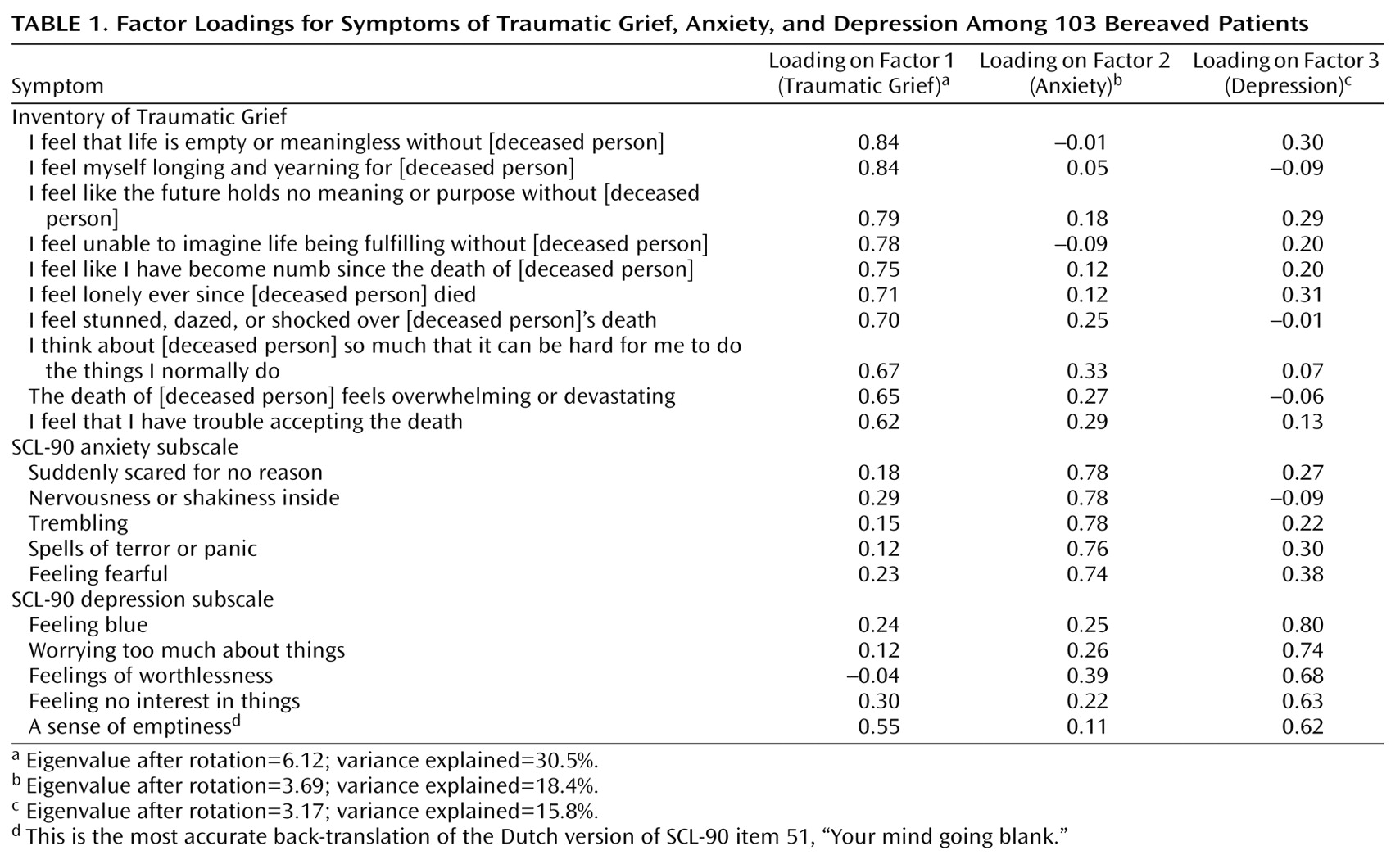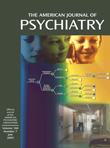Several studies have shown that symptoms of traumatic grief constitute a distinct form of bereavement-related emotional distress apart from bereavement-related depression and anxiety
(1). Using data on recently widowed elders, Prigerson et al.
(2) found that symptoms of traumatic grief (e.g., searching, preoccupation) were distinct from those of bereavement-related depression (e.g., apathy, depressed mood). Prigerson et al.
(3) found that traumatic grief could be distinguished from both bereavement-related depression and anxiety in a community-based sample of recently bereaved elderly widows and widowers.
To our knowledge, the distinctiveness of the three symptom clusters has never been investigated with individuals other than recently bereaved elders whose partners died from illness. Replication of this distinctiveness with other groups is important in order to be able to determine the generalizability of previous results. The importance of replication is strengthened by the fact that high levels of traumatic grief symptoms have been found to predict subsequent physical and mental health impairments
(1).
The aim of this study was to confirm that symptoms of traumatic grief are distinct from those of bereavement-related depression and anxiety in a group of outpatients who had sought help for problems with grief after the death of a first-degree relative (partner, parent, child, or sibling).
Method
Data were available for 103 outpatients from different outpatient clinics in the Netherlands. Forty-seven of them were originally recruited for an ongoing grief intervention study; they had sought treatment at their own initiative or had responded to advertisements announcing the study. The other patients were originally solicited for a study on the psychometric properties of the Dutch version of the Inventory of Traumatic Grief
(4). They had sought help at their own initiative or were referred to one of the clinics by a physician. All patients underwent an intake interview, in which eligibility for the studies was checked. Subsequently, they completed different questionnaires. Included in the present study were patients who had suffered the loss of a first-degree relative, had experienced the loss at least 2 months earlier, were over 18 years of age, and reported having emotional problems with grief. The patients from the two studies who met these criteria did not differ from each other with respect to age, gender, time since the loss, variation in kinship to the deceased and cause of loss, and symptom severity. Written informed consent was obtained from all patients.
According to the psychotherapists who conducted the intake interviews, 26 (25.2%) of the patients met the DSM-IV criteria for a depressive disorder, three (2.9%) met the criteria for an anxiety disorder, and 10 (9.7%) met the criteria for both a depressive and an anxiety disorder. None of the participants was receiving treatment at the time of the assessment, and 24 (23.3%) were using antidepressant medication. The participants’ mean age was 44.0 years (SD=13.1). Most participants (74.8%) were female (N=77). The relative who had died was a spouse for 33.0% of the subjects (N=34), a child for 29.1% (N=30), a parent for 28.2% (N=29), and a sibling for 9.7% (N=10); 42.7% of the participants (N=44) had lost a loved one through illness. On average, 41.7 months (SD=61.4) had passed since the loss.
Items for the traumatic grief factor were taken from the Inventory of Traumatic Grief, a 30-item questionnaire for assessing the severity of traumatic grief symptoms
(1). The Dutch version of the Inventory of Traumatic Grief has been found to possess adequate reliability and validity
(4). Items for the depression and anxiety factors were taken from the Dutch version
(5) of the 17-item depression subscale and 10-item anxiety subscale of the SCL-90
(6). Items in both subscales closely relate to depressive and anxious states as described in DSM-IV.
To gain insight into the degree of distress among our subjects, the symptom scores were compared with those for reference groups. Principal axis factoring with varimax rotation was performed to determine how the selected pool of items clustered together. Constraints of the study group size limited the number of items that could be included in this analysis. Consequently, we selected 10 items from the Inventory of Traumatic Grief, five items from the SCL-90 depression subscale, and five items from the SCL-90 anxiety subscale. We selected the items that were among the most highly correlated with each scale’s total score. An eigenvalue greater than 1.00 was the criterion used to determine the number of factors underlying the items.
Results
The mean score of these patients on the Inventory of Traumatic Grief (mean=91.62, SD=19.08) was significantly higher than the mean score found in a Dutch subclinical sample of 250 individuals who had lost a first-degree relative (mean=82.52, SD=20.14) (t=4.84, df=102, p<0.001) (4). The patients were also compared with men and women in Dutch psychiatric outpatient reference groups (5). The SCL-90 depression score of the men in this study (mean=45.27, SD=18.72) was above average, while their SCL-90 anxiety score (mean=24.69, SD=11.32) was average. The depression score of the women (mean=48.47, SD=11.13) was average, while their anxiety score (mean=24.53, SD=9.35) was below average. The symptom scores were not influenced by time since the loss, kinship to the deceased, or cause of death.
With respect to the principal axis factoring, examination of the eigenvalues extracted before rotation showed the emergence of three factors with eigenvalues of 8.94, 2.68, and 1.34, accounting for 64.7% of the variance. The items sorted themselves in three distinct factors (
Table 1). The first factor accounted for 30.5% of the variance. Symptoms of traumatic grief loaded highly on this factor, with factor loadings ranging from 0.62 to 0.84 and no loadings above 0.33 on the other two factors. The second factor accounted for 18.4% of the variance. Symptoms of anxiety had the highest factor loadings on this factor (ranging from 0.74 to 0.78) with no loadings above 0.38 on the other factors. The third factor accounted for 15.8% of the variance. Symptoms of depression clustered together in this factor, with factor loadings ranging from 0.62 to 0.80 and no loadings above 0.55 on the other two factors.
Discussion
With a group of midlife Dutch psychiatric outpatients who had suffered the loss of a first-degree relative on average nearly 3.5 years previously, we were able to replicate the distinctiveness of three symptom clusters: traumatic grief, bereavement-related depression, and bereavement-related anxiety. The findings suggest the cross-cultural generalizability of earlier findings with a U.S. community-based sample of late-life individuals whose spouses had recently died
(2,
3).
The results indicate that the complications of bereavement may include symptoms of traumatic grief that constitute a clinical entity distinct from bereavement-related depression and anxiety. This contrasts with DSM-IV, in which traumatic grief is not a separate clinical entity. The results suggest that different treatment methods may be required for the various syndromes that develop in people who fail to recover from bereavement (e.g., medication for depression symptoms, anxiety management for symptoms of anxiety, and exposure for traumatic grief). The development and evaluation of such specific treatment methods is an important challenge for future research.


